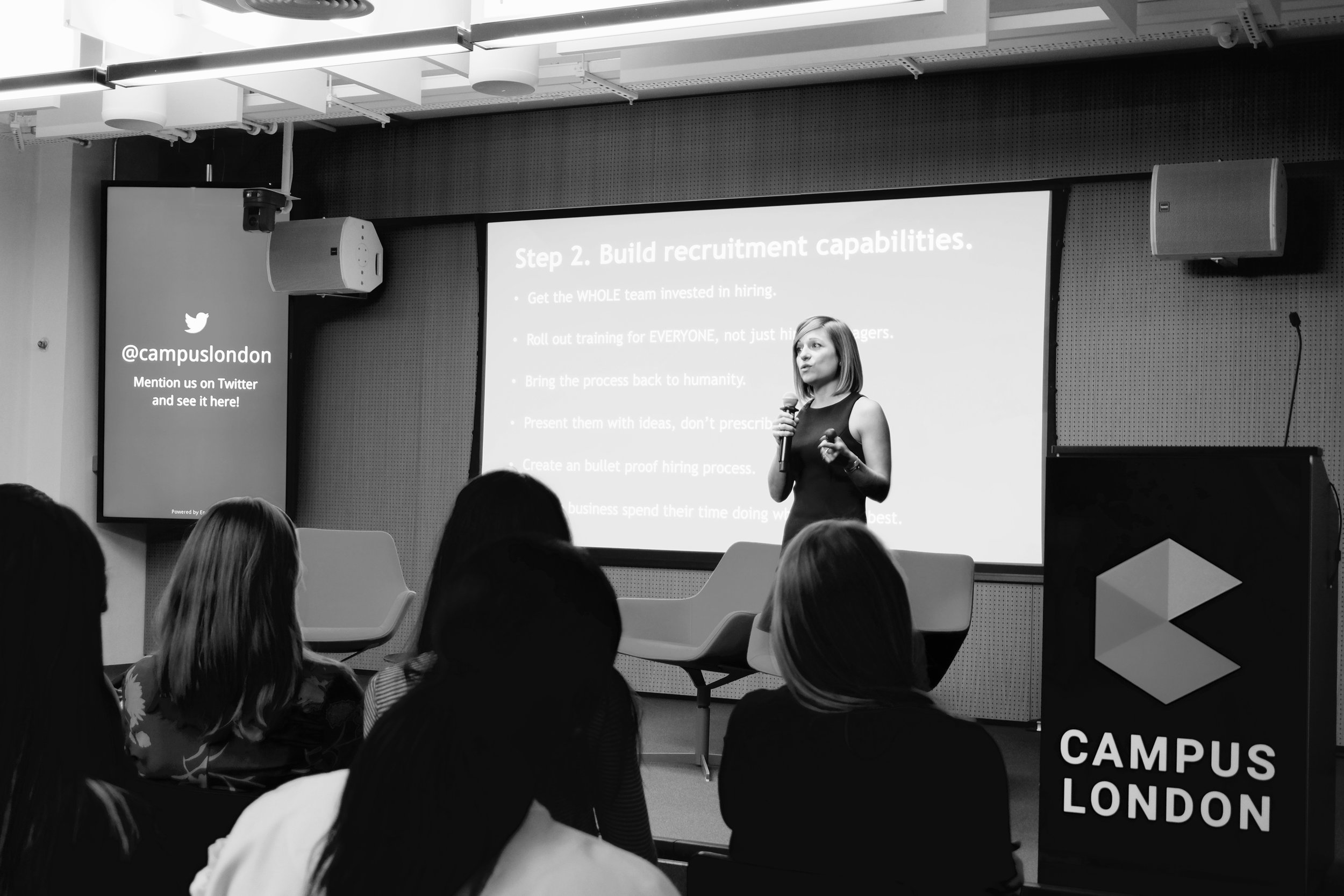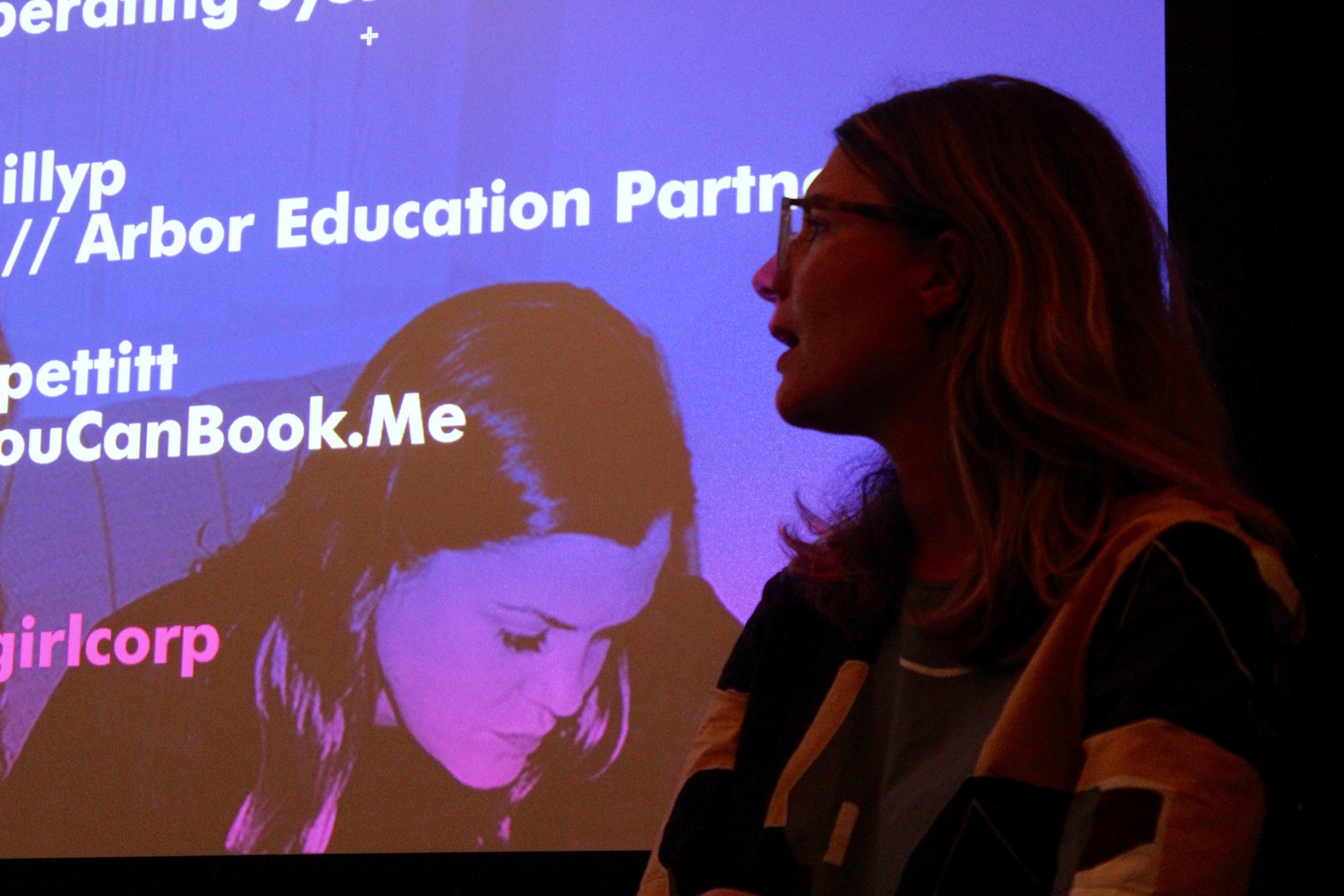Always Be Hiring

Your company is finally off the ground and it's time to think about building the right team to take it to the next level. But wait - who should be your first hire? Where do you find the right people to create your ideal A-Team? How do you sell your idea to them when you don't have a lot of cash to splash on staff? All was revealed at our eighth panel of the year, where attendees learned that hiring people is just like finding a romantic partner and attraction, honesty and passion can go a long way in turning the dating process into a business marriage.
The Panel
Ruth Penfold, Director of Talent Acquisition at Shazam, an app that can identify music and media playing around you.
Sharmadean Reid, Founder of WAH London and FutureGirlCorp, platforms that empower women through style (former) and business (latter).
The Recruitment Process
...the who, what, why, where of recruiting!
BE SELF AWARE! Hiring is like dating - you can't start up a relationship with someone else until you understand who you are and what you're about. So lose all the filters and spend some QT time with yourself, breaking down the pros and cons of your business, your purpose and your mission. Write down the values of your company because they will underpin everything, from the hiring process to performance reviews. Once you figure that out, you can start hunting for the tribe who will buy into your idea too.
NETWORK! In case you missed it, we'll say it again - hiring is like dating! The possibilities are endless when it comes to meeting the right people. They could be sitting next you at an event, on the bus, in an exercise class, who knows - so don't be afraid to get out there and mingle. Your perfect meet-cute could be waiting right around the corner. And yes, it can be daunting walking up to people you don't know and introducing yourself so here are some conversation starters/pickup lines to try:
- Hello, I'm ... , what's your name?
- What do you do?
- What are you doing here?
- Come here often?
- What are you working on right now?
- What's your background?
- Are you going to eat all that pizza?
Easy, peasy and hopefully you'll get lucky with a date.
PREPARE FOR THE INTERVIEW! When it comes to interviewing, implement a structure that keeps your company looking professional. Create a word document or a google spreadsheet that maps out your hiring process, from the interview questions to delegating who will send out an email explaining the applicant has been successful. It might seem basic but ensuring these small details run smoothly will make your brand look slick and welcoming.
General Hacks:
- Include a discussion about brand values, the interviewee's motivators and productivity level, your expectations, their expectations and future goals.
- Use Charlie HR, a free software that will help you with the hiring process and managing people's details, email set up, etc...
- If successful, send out a little gift before someone joins you. Call them to update them on the business, if there is a gap between the interview and when they start work. Things like this help get your potential employees feeling valued and important.
“Recruitment relationships begin everywhere.” - Ruth Penfold, Shazam.
DON'T BE AFRAID TO NEGOTIATE! With the recruitment process, everything is up for negotiation - whether using a recruitment agency to help you hire or working out the kinks in salary expectations. Draft a budget for what you're willing to spend on the recruitment process, bearing in mind that agents normally take approx. 7 - 20 % of an employee's salary. However, this will only be charged once you've appointed someone and they begin work. Make sure to include terms around what happens if the person you've hired doesn’t work out.
USE BRAND AMBASSADORS! Once your team starts growing, they'll become the biggest source of free advertising that you have. Thus, it's in your best interest to invest in making them the best version of themselves and parading your A-Team to the world. Use free platforms to get their faces out there and encourage them to think about their online presence and what they are projecting about your company to everyone else. After all, happy employees attract more employees!
“Because I took it seriously, I got serious candidates.” - Sharmadean Reid, WAH London
The Culture Value
...showing the world what you're about will attract not just customers but employees too!
SHOW SOME PASSION! The best way to get people onboard with your company is by getting them excited to be part of the experience. A founder’s excitement feeds the business so from the get-go, explain why and how your business is going to change the life of your customer, as well as why they should join up. Hiring an employee is really asking someone to come on a journey with you, especially in the beginning. As such, you need to be the most transparent version of yourself because you’ll be spending a lot of time with these people.
CREATE A DECK! Your values are the values of your business, so you'll need to create a deck with the information about what your organisation is about as soon as possible. That way your future staff understand the code of your company and you'll be creating citizens that can cope on their own when you’re not around to constantly feed them energy and enthusiasm. Google other companies’ values, especially tech ones. Look out for the words and symbols that inspire you and feed that into how you manage people.
“[Just as you'd] pitch to an investor, you’re pitching those same principles to your potential employees.” - Amy Thomson, Seen.
BE WELCOMING! First days are scary, so go above and beyond to make your new employee feel welcome. Make sure the equipment they need to work is ready. Get them a welcome present: a coffee or a notebook to make them feel more at home. Whatever you do make it special because you want them going home at the end of the day feeling excited and happy to have joined your team. Accept that you’re going to need to take time out during their first week to help them understand where everything is, set them up on the wifi system, answer all the questions they may have, etc... After that, set them up on a buddy system if you have enough bodies to do so.
The Grey Areas
...beware the dos and don'ts of the hiring process!
DON'T HIRE IN YOUR IMAGE! Get to grips with what you're good at and what you're not good at, then hire people to do the stuff you're not good at. It's important to understand your own personality before adding other personalities into the mix. Use psychometric tests, such as the 16 Personalities Test, to find out your own personality type and establish what else you need to run your business. So if you're an entrepreneur that enjoys getting out there and pushing the work, you need someone that enjoys staying in to do the work. During the interview process, get the interviewee to take the test in order to gain insight into whether they are the right fit for you and your company.
“A good leader recognises the things that they aren’t good at and hires people that can do that stuff!” - Ruth Penfold, Shazam.
DO LISTEN TO YOUR GUT! We wish there was an exact science to hiring the right people but until someone comes up with a formula, you've just got to go with your gut. Again, it's like dating - you click with some people but feel plain awkward around others. Read energy and pay attention to your instincts. If someone is making you feel weird it could be a warning sign.
DON'T BE FOOLED THAT EVERYONE WILL BE AS PASSIONATE ABOUT YOUR BUSINESS AS YOU ARE & DO UNDERSTAND WHAT MOTIVATES OTHERS! Be aware that as a founder you are 100% passionate about your business but not everyone will feel the same way. Find out what motivates people to work hard for your company - whether money, deeper purpose or gaining experiences and skills. Understanding what drives your employees will help you in managing them better.
The Break Up
...omg it's not working out anymore, what I do?!
PROBATIONS & PERFORMANCE PLANS! Everyone in your company should undergo a probation period. If someone isn’t meeting their targets, then you can have a sit down with them to discuss why that is happening. If after that, they still aren’t improving then you'll need to map it out in a performance review. The best thing you can do for both parties is to take a very honest and straightforward approach.
KEEP A PAPER TRIAL! Everything you do with employees is about processes, so make sure you go through the right procedures when hiring and keep a record of absolutely everything. That way, if someone is underperforming you have a record to prove that you're not being unjust. It's really important to be fair to people and give them a real opportunity to turn it around, but also make sure you’re covering yourself and your company within this process. Even if it's just emails, please keep a paper trail!
COMMUNICATE VERBALLY! Human beings are complex and often times things can get misconstrued over the web. Take the time to explain what's not working in person. People will respect you for having the guts to talk to them IRL, even if only to feel like their side of the story is heard. Ask them whether they are happy because if someone is underperforming in your business, it may just be that they don’t want the job anymore or they are struggling with personal issues at home. Whatever the case is, always remain respectful and professional.
“If someone isn’t performing, what you need is total clarity.” - Ruth Penfold, Shazam.
CHECK YO SELF! If it has to come to an end, complete an exit interview with the individual in order to analyse yourself as a leader, as well as whoever else was managing them. Get under the skin of why they are leaving: it could be that their living situations have changed or personal issues have come up. Or it could be that there was a breakdown in the management process. Once you know what the issue was, you can strategically address it with the next employee so as to avoid it happening again.
REPEAT WITH FREELANCERS! Not everyone working for your company will be a PAYE employee, especially in the beginning. You might not necessarily put a freelancer on a contract but it is helpful to create a scope or a term sheet, highlighting what you expect from them e.g. project deadlines, etc… It also means that if they aren’t performing - in exactly the same way as you’d address it with a permanent staff member - you can have the discussion about why targets aren’t being met and discuss whether this situation is working out for both parties.
DON'T GET TOO ATTACHED! Come to terms with the fact that people will leave - it's a reality of any business. The investment you put into a member of your team won’t come back in the same way, so don’t expect everyone to be ride or die for your company. Be a grown up, pick yourself up, wish them the best of luck and then just let it go.
“You have to learn to not get too attached to your team because it can be debilitating ... mourning a team member.” - Sharmadean Reid, WAH London.
THE Q&AS
1. Offering internships and work experience - good or bad idea?
“I like to not use interns as substitute labour but as a funnel for potential employees.” - Sharmadean Reid, WAH London
Money is always a tricky conversation when it comes to offering internships and work experience, especially at the beginning of your company. Where you can, offer paid opportunities. Some people can’t afford to do a free internship but they should still have the chance to get involved as well. It doesn’t have to be a fortune but every little helps. However, we understand that paying interns is not always possible, so have an open discussion with those interested about working for free. If they are still willing, it's a sign they are truly passionate - something you'll want to tap into. Interview them, as you would any other employee, give them clear guidelines on the work they'll be doing and watch how innovate they are. Once their internship comes to an end, you might be interested in hiring them permanently.
P.S. As you grow, internships are a great way to train your junior staff on how to interview people. This is helpful for building and testing out a recruitment structure, so that when you come to hiring someone more senior, you'll feel confident that your staff can pick the right person.
2. How much value do you place on university degrees when hiring?
It’s not necessarily about having a degree, it’s about their passion and persistence. Can they give you previous examples of work that demonstrate their commitment and dedication to a particular project? Be open to giving opportunities to anyone that can show you their capabilities in meeting your required targets. Just be aware that those without a university degree might struggle more with their public speaking and writing abilities. However, it's nothing a short course can't help with - something you might be able to integrate into their position at your company.
3. Who is the first important hire?
“[Ask youself] what is the thing that is stopping me progressing to the next milestone?” - Sharmadean Reid, WAH London.
The answer to that question is who your next hire should be based around.
4. Hiring a senior position - is it different from your regular hires?
“Hiring senior people starts way before you actually hire them... it's a different ballgame.” - Sharmadean Reid, WAH London.
When it comes time to hire a more senior role within your company, building relationships is key. You'll need to spend time going to the kind of networking events and hanging around the circles that those type of people gravitate towards. You could even take recommendations from other people to source good potentials. Once you've found someone that you think would work well within your team - someone who is looking for a deeper purpose - you'll need to start grooming them to want to work for you. This might be over dinner or coffee dates, catch ups over the phone, etc... Also, don't rule out people that you already work with or are working their way up to senior positions in other companies - it can save you quite a big chunk of cash when it comes to paying their salary, if they aren't already in those senior positions.
5. Working with remote staff - safe or unsafe?
It's much harder to build a company culture with staff who work remotely but sometimes it can't be helped. To avoid resentment and mistrust building up - when worrying that they might not be working efficiently at home - make sure to check in with them regularly, emailing twice a day to see how they are getting on, providing them with a detailed guideline about their day to day role and meeting up in person monthly. When appropriate, keep your conversations casual and connect with your staff in a fun and lighthearted way. Office banter and relationship building is often missed when working remotely.
6. How do you keep unpaid staff motivated?
Be really transparent and upfront with what you can offer them and be realistic with your expectations of them. It’s okay to take some time to work out your relationship before offering them a permanent and paid position.
7. While working in a 9-5, when’s the point you need to hire someone else to help with your business?
“If you’re not committed to your business, why would someone else be?” - Sharmadean Reid, WAH London.
You have to make the leap first before asking people to make the leap for you. If you’re at the point where you’re thinking about hiring someone but still in full-time employment, why not cut down your hours and take some of that money saved to support yourself whilst you dedicate more time to your business? Then you can always bring in some additional, temporary support to fill in the blanks when you're not available.






















